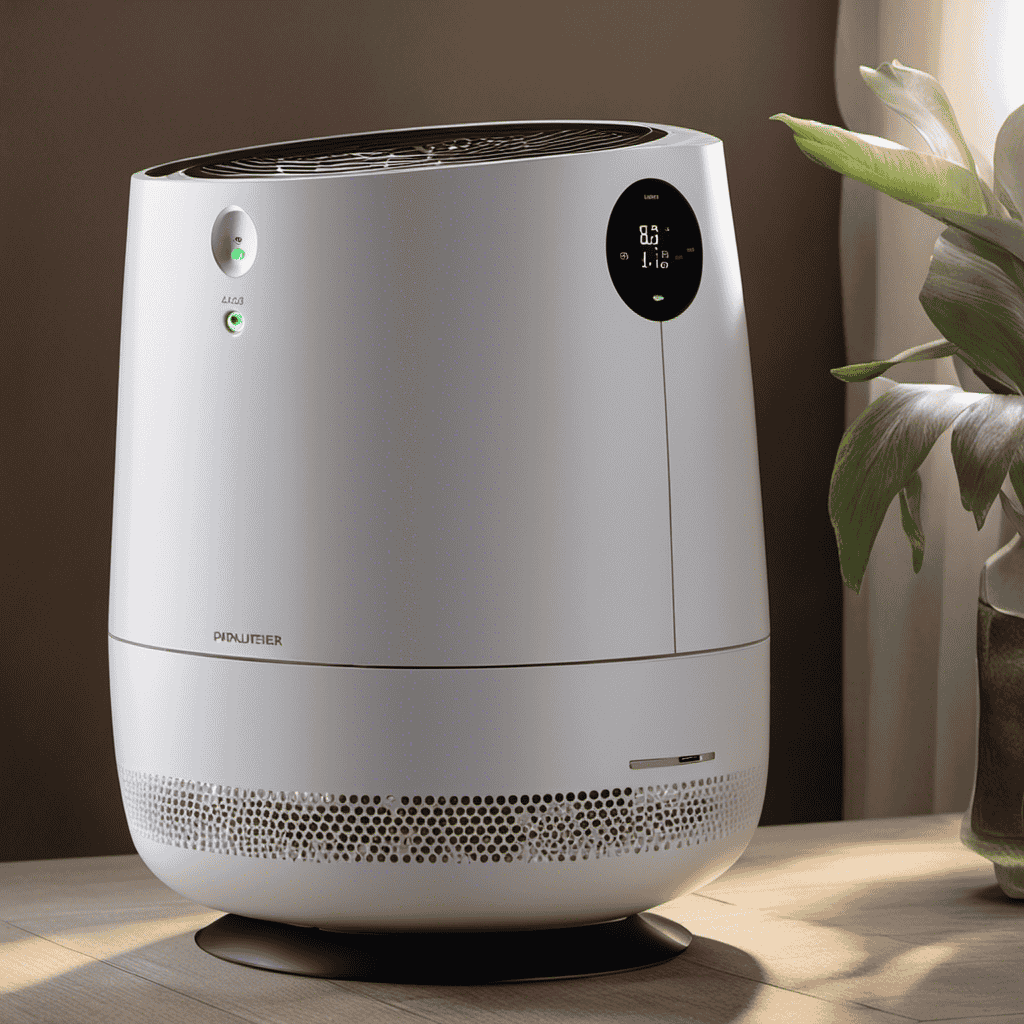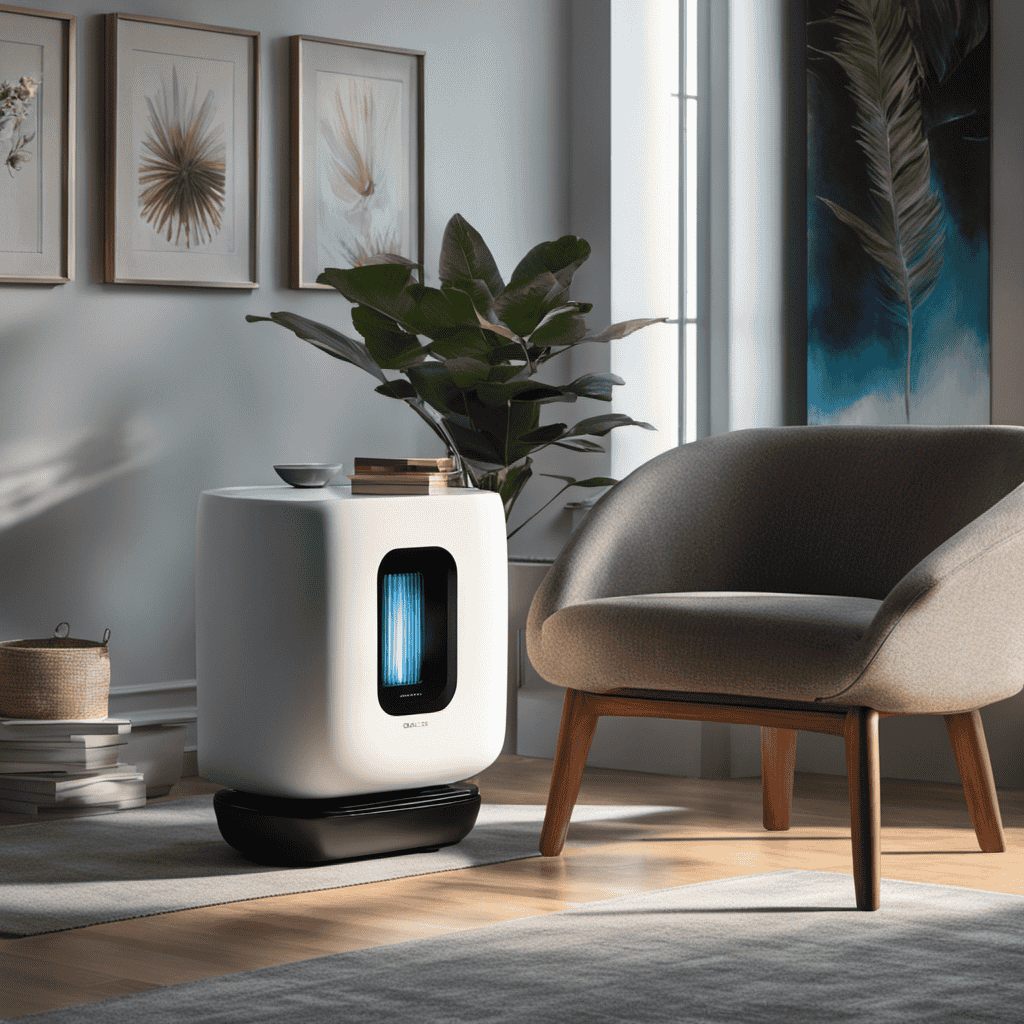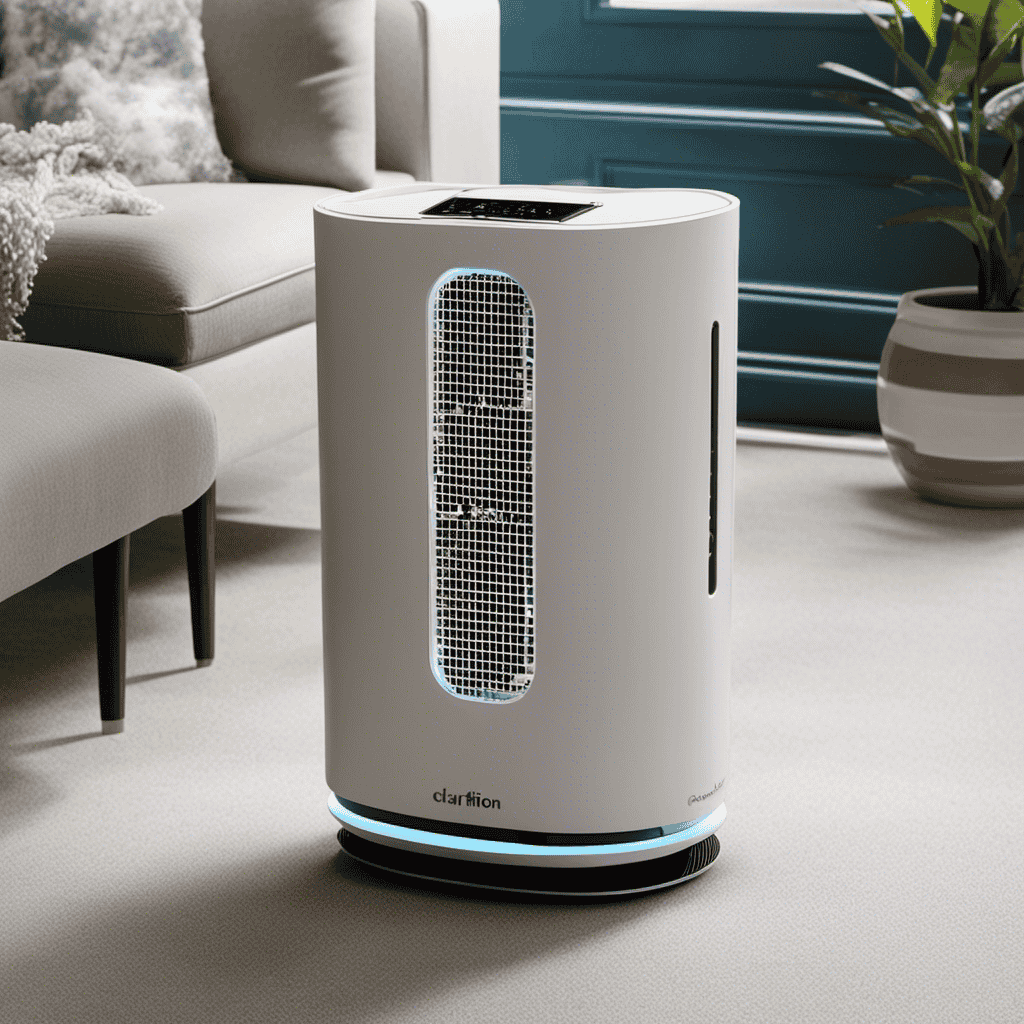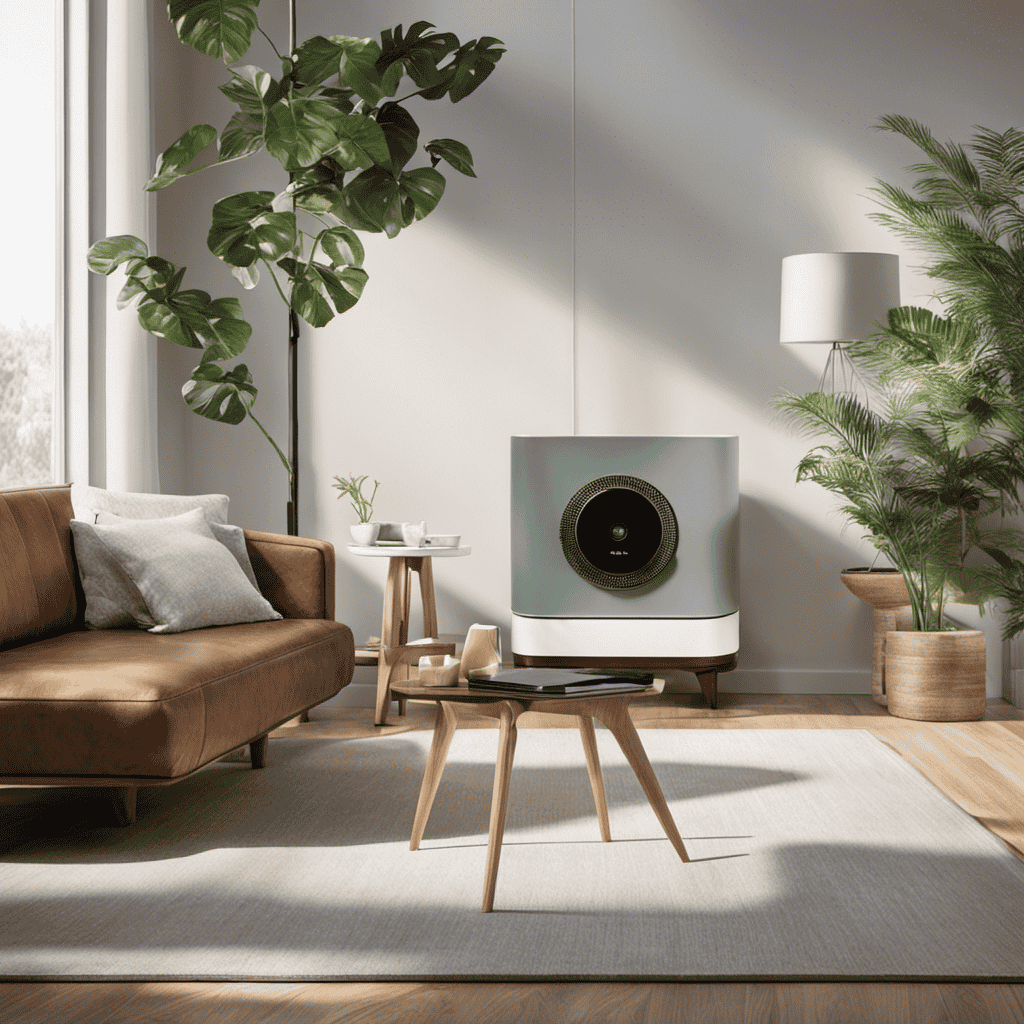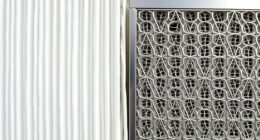Were you aware that the air inside our homes may be up to five times more polluted than the air outside?
That’s why having an efficient air purifier is crucial for maintaining a healthy indoor environment.
In this article, I will discuss the importance of CADR (Clean Air Delivery Rate) ratings in air purifiers.
Understanding how CADR ratings measure air purification efficiency and the factors that affect them will help you make an informed decision when choosing the right air purifier for your needs.
Key Takeaways
- CADR ratings are a standardized measurement that indicate the effectiveness of an air purifier in removing specific pollutants from the air.
- Factors such as the type and size of the filter, fan speed, and overall design of the unit can affect CADR ratings.
- Consumers should consider the size of the room, the specific needs of their household, and the types of pollutants they want to remove when choosing the appropriate CADR rating for their air purifier.
- Customer reviews and testimonials, as well as objective measurements of air quality improvement, can provide insights into the real-life performance of air purifiers.
Understanding CADR Ratings
To understand CADR ratings, you’ll need to know that they measure the effectiveness of an air purifier in removing specific pollutants from the air. When it comes to making air purifier purchase decisions, CADR ratings play a crucial role. These ratings provide valuable information about the device’s ability to purify the air in your home or office, helping you choose the most effective option for your needs.
CADR stands for Clean Air Delivery Rate, and it measures the amount of clean air an air purifier can deliver in a specific timeframe. This rating is determined through rigorous testing conducted by independent laboratories, ensuring accurate and reliable results. The CADR rating is given for three main types of pollutants: smoke, dust, and pollen.
Interpreting CADR ratings is essential for optimal air purification. A higher CADR rating indicates that the air purifier can remove a greater amount of pollutants from the air. For example, an air purifier with a CADR rating of 300 for smoke particles can remove smoke particles at a faster rate compared to a device with a lower rating. Therefore, it is advisable to choose an air purifier with high CADR ratings for all three pollutant categories to ensure efficient air purification.
Importance of CADR Ratings in Air Purifiers
The importance of CADR ratings is that they help consumers choose the most effective air purifiers. When it comes to air purifiers, we all want to ensure that we are breathing in clean and healthy air. CADR, or Clean Air Delivery Rate, is a standardized measurement that tells us how quickly an air purifier can remove common airborne pollutants from a specific room size. By considering CADR ratings, consumers can make informed decisions and select air purifiers that are best suited for their needs.
There are several factors that can affect CADR ratings in air purifiers. These include the type and size of the filter used, the fan speed, and the overall design of the unit. For example, air purifiers with larger filters and higher fan speeds tend to have higher CADR ratings, as they can move more air and capture more pollutants. On the other hand, air purifiers with smaller filters or lower fan speeds may have lower CADR ratings and may not be as effective in cleaning the air.
To better understand the importance of CADR ratings, let’s take a look at the following table:
| Air Purifier Model | CADR Rating (Smoke) | CADR Rating (Dust) | CADR Rating (Pollen) |
|---|---|---|---|
| Model A | 300 | 250 | 200 |
| Model B | 400 | 350 | 300 |
| Model C | 250 | 200 | 150 |
| Model D | 350 | 300 | 250 |
As we can see from the table, models B and D have higher CADR ratings compared to models A and C. This means that models B and D are more efficient in removing smoke, dust, and pollen particles from the air. By considering CADR ratings, consumers can make an informed decision and choose an air purifier that will effectively improve the air quality in their homes.
In the next section, we will explore how CADR ratings measure air purification efficiency and the factors that contribute to a high CADR rating.
How CADR Ratings Measure Air Purification Efficiency
CADR ratings measure how efficiently air purifiers clean the air by indicating how quickly they remove common airborne pollutants. When evaluating CADR ratings for pet hair removal, it is important to consider the impact of these ratings on indoor air quality improvement.
Pet hair, dander, and allergens can significantly affect the air quality in our homes, leading to allergies and respiratory issues. Therefore, it is crucial to choose an air purifier with a high CADR rating for pet hair removal to effectively eliminate these pollutants from the air.
CADR ratings are determined through rigorous testing conducted by independent laboratories. These tests measure the air purifier’s ability to remove particles of different sizes, including pet hair and dander. The higher the CADR rating for pet hair removal, the more efficiently the air purifier can capture and eliminate these pollutants.
By selecting an air purifier with a high CADR rating for pet hair removal, we can improve indoor air quality and create a healthier living environment for both humans and pets. The efficient removal of pet hair and dander can help reduce allergies and respiratory issues caused by these pollutants. Additionally, it can also minimize the accumulation of pet hair and dander on furniture and surfaces, making it easier to maintain a clean and hygienic home.
Factors Affecting CADR Ratings
Factors such as room size, filter type, and fan speed can impact the efficiency of an air purifier’s pet hair removal.
When it comes to pet hair, larger room sizes require air purifiers with higher CADR ratings to effectively remove the hair. This is because the purifier needs to circulate and filter more air in a larger space.
The filter type also plays a crucial role in pet hair removal. HEPA filters are highly effective at capturing pet dander and hair, making them the ideal choice for households with pets.
Additionally, the fan speed of an air purifier affects its ability to remove pet hair. Higher fan speeds result in increased air circulation, which improves the purifier’s overall efficiency.
Measurement methods are also important when evaluating an air purifier’s pet hair removal capabilities. CADR, or Clean Air Delivery Rate, is a widely recognized measurement method that determines how quickly an air purifier can remove specific particles from the air. CADR ratings provide valuable information about an air purifier’s performance in removing pet hair. A higher CADR rating indicates a more efficient removal of pet hair and other particles.
It is recommended to look for air purifiers with higher CADR ratings specifically for pet hair removal.
Choosing the Right CADR Rating for Your Air Purifier
When choosing the right CADR rating for your air purifier, you’ll want to consider the size of the room and the specific needs of your household. The CADR rating, or Clean Air Delivery Rate, measures the effectiveness of an air purifier in removing pollutants from the air. A higher CADR rating indicates a faster and more efficient purification process.
Here are three important factors to consider when selecting the appropriate CADR rating:
-
Room Size: The CADR rating should be based on the square footage of the room. A larger room will require a higher CADR rating to effectively clean the air.
-
Pollutant Types: Different air purifiers excel at removing specific types of pollutants, such as smoke, dust, or pollen. It’s crucial to choose a CADR rating that matches the specific pollutants present in your environment.
-
Allergies and Sensitivities: If you or your family members suffer from allergies or respiratory conditions, a higher CADR rating can significantly improve air quality and provide relief from symptoms.
Selecting the right CADR rating for your air purifier is essential for maintaining clean and healthy indoor air. By considering the size of the room and the specific needs of your household, you can ensure that the air purifier effectively removes pollutants, resulting in improved air quality and overall well-being.
CADR Ratings Vs. Room Size: Finding the Right Balance
To find the right balance between CADR ratings and room size, you’ll want to consider the square footage of the space and how effectively the air purifier can clean the air. When it comes to air purifiers, the CADR rating is a crucial factor to consider. However, it’s important to understand that CADR ratings alone may not give you a complete picture of an air purifier’s performance in real-life situations.
One important aspect to consider is the type of filter used in the air purifier. Different filter types have varying levels of effectiveness in capturing different pollutants. For example, HEPA filters are highly efficient at removing particles as small as 0.3 microns, while carbon filters are effective at trapping odors and volatile organic compounds (VOCs). Understanding the filter types and their capabilities can help you choose an air purifier that suits your specific needs.
Additionally, it’s important to set realistic expectations when it comes to the performance of an air purifier. While CADR ratings provide a general idea of an air purifier’s effectiveness, it’s important to remember that real-life performance can be influenced by factors such as room layout, air circulation, and the presence of other sources of pollutants. It’s important to consider these factors when determining the appropriate CADR rating for your specific room size.
Common Misconceptions About CADR Ratings
When it comes to choosing an air purifier, understanding the relationship between CADR and room size is crucial.
CADR, or Clean Air Delivery Rate, measures the efficiency of an air purifier in removing common pollutants from the air.
It is important to find the right balance between the CADR rating and the size of the room to ensure optimal performance.
Additionally, the type of filter used in an air purifier plays a significant role in its effectiveness.
Filters like HEPA (High Efficiency Particulate Air) are known for their ability to capture small particles, while activated carbon filters can effectively remove odors and chemicals.
Lastly, it is essential to have realistic expectations about the performance of an air purifier in real-life conditions.
Factors such as indoor air quality, exposure to pollutants, and the presence of other mitigation measures can affect the overall effectiveness of an air purifier.
CADR Vs. Room Size
If you want to effectively purify the air in your room, you should consider the CADR rating in relation to the room size. The CADR, or Clean Air Delivery Rate, measures the efficiency of an air purifier in removing pollutants from the air. It is crucial to choose an air purifier with a CADR rating that matches the size of your room to ensure optimal air quality.
Here are three key points to consider when it comes to CADR ratings and room size:
- A higher CADR rating means the air purifier can remove more pollutants, leading to better air quality.
- If the CADR rating is too low for the room size, the air purifier will not be able to effectively clean the air.
- Choosing an air purifier with a CADR rating that exceeds the room size can lead to unnecessary energy consumption.
Considering the right CADR rating in relation to your room size is essential for both air quality and energy efficiency. However, it’s important to also consider the filter type, which we will discuss in the next section.
Importance of Filter Type
The type of filter you choose for your air purifier plays a significant role in maintaining optimal air quality. There are different filter options available, each with its own set of benefits and considerations.
The most common types of filters include HEPA filters, activated carbon filters, and electrostatic filters. HEPA filters are highly effective at removing small particles such as dust, pollen, and pet dander. Activated carbon filters are excellent at absorbing odors and chemicals. Electrostatic filters use an electric charge to attract and trap particles.
It is important to regularly clean and replace your air purifier filters to ensure their effectiveness. Follow the manufacturer’s guidelines for filter maintenance, which may include vacuuming or washing the filters, or replacing them entirely.
Real-Life Performance Expectations
To get a better idea of how well an air purifier performs in real-life situations, you can look for customer reviews and testimonials. Evaluating real-life performance is crucial in measuring air purifier efficiency.
Here are some key factors to consider:
-
Noise level: Customers often comment on the noise level of air purifiers during operation. A quiet unit is important for uninterrupted sleep or peaceful work environments.
-
Air quality improvement: Look for reviews that mention noticeable improvements in air quality, such as reduced dust, allergens, or odors. Objective measurements, such as reduced PM2.5 levels, can provide more accurate assessments.
-
Energy efficiency: Consider the energy consumption of the air purifier. Some models may be more energy-efficient than others, helping you save on electricity costs.
The Role of CADR Ratings in Allergen Removal
Understanding the role of CADR ratings is crucial in assessing the effectiveness of an air purifier in removing allergens. For asthma sufferers, it is particularly important to consider CADR ratings when selecting an air purifier, as indoor air quality improvement is crucial for managing their condition. CADR stands for Clean Air Delivery Rate and it measures the amount of clean air that an air purifier can deliver in a specific space. The higher the CADR rating, the more effective the air purifier is in removing allergens such as pollen, dust, and pet dander.
CADR ratings are important for asthma sufferers because their condition is often triggered by allergens present in the air. By choosing an air purifier with a high CADR rating, asthma sufferers can significantly reduce their exposure to these allergens, leading to better respiratory health. The table below illustrates the CADR ratings for different allergens and the recommended CADR rating for asthma sufferers:
| Allergen | Recommended CADR Rating |
|---|---|
| Pollen | 120 or higher |
| Dust | 100 or higher |
| Pet Dander | 100 or higher |
CADR Ratings and Smoke Removal: What You Need to Know
When it comes to smoke removal, you need to pay attention to CADR ratings in order to effectively improve indoor air quality. CADR, or Clean Air Delivery Rate, is a metric that measures an air purifier’s ability to remove smoke particles from the air. By understanding the CADR ratings, you can make an informed decision about which air purifier is best for your needs.
Here are three key points to consider when it comes to CADR ratings and smoke removal:
-
CADR ratings and indoor air quality:
- Higher CADR ratings indicate a faster and more efficient smoke removal process.
- A higher CADR rating means that the air purifier can remove a larger volume of smoke particles per minute.
- Choosing an air purifier with a CADR rating that matches the size of your room ensures optimal smoke removal and improved indoor air quality.
-
CADR ratings and respiratory health:
- Smoke particles can have harmful effects on respiratory health, especially for individuals with asthma or allergies.
- By selecting an air purifier with a high CADR rating for smoke removal, you can reduce the concentration of smoke particles in the air, minimizing the risk of respiratory issues.
- Improved indoor air quality, achieved through effective smoke removal, can lead to a healthier living environment.
-
CADR ratings and effectiveness:
- CADR ratings are determined through rigorous testing conducted by independent organizations.
- These ratings provide an objective measure of an air purifier’s performance in removing smoke particles.
- By considering CADR ratings, you can choose an air purifier that has been proven to be effective in smoke removal, giving you peace of mind about its performance.
The Impact of CADR Ratings on Odor Elimination
In my previous subtopic, I discussed the importance of CADR ratings in relation to the removal of smoke particles. Now, I will delve into another critical aspect of CADR ratings: their impact on odor elimination.
CADR ratings not only indicate the effectiveness of an air purifier in removing smoke particles, but also play a significant role in addressing unpleasant odors. Odors can be caused by various sources, such as cooking, pets, or chemical off-gassing. By investing in an air purifier with a high CADR rating for odor removal, you can ensure a fresher and more pleasant indoor environment.
The impact of CADR ratings on energy consumption is another crucial consideration. Higher CADR ratings generally require more energy to operate, as the air purifier needs to work harder to achieve a higher air exchange rate. Therefore, it is essential to strike a balance between CADR ratings and energy efficiency when selecting an air purifier.
Moreover, CADR ratings have a direct correlation with indoor air quality. Higher CADR ratings indicate a more effective removal of pollutants, leading to improved indoor air quality. This is particularly important for individuals with respiratory conditions or allergies, as cleaner air can alleviate symptoms and improve overall health.
Now that we have explored the impact of CADR ratings on odor elimination and energy consumption, let’s move on to the next subtopic: CADR ratings and the removal of volatile organic compounds (VOCs).
CADR Ratings and the Removal of Volatile Organic Compounds (VOCs
When it comes to evaluating the effectiveness of air purifiers in removing volatile organic compounds (VOCs), one important aspect to consider is the CADR (Clean Air Delivery Rate) ratings. These ratings provide an indication of how efficiently an air purifier can remove airborne pollutants, including VOCs.
However, there is some debate surrounding the reliability of CADR ratings as a measure of VOC removal effectiveness. This is because they may not accurately reflect real-world conditions and may not account for the specific types and concentrations of VOCs present in a given environment.
VOC Removal Effectiveness
The air purifier’s VOC removal effectiveness is quite impressive. It utilizes various VOC removal techniques to efficiently eliminate harmful pollutants from the air. Here are some benefits of VOC removal:
-
Improved Indoor Air Quality: VOCs can be found in common household items such as cleaning products, paints, and furniture. Removing these compounds helps create a healthier environment by reducing the risk of respiratory issues and other health problems.
-
Odor Reduction: VOCs are often responsible for unpleasant odors. By removing these compounds, the air purifier helps to eliminate unwanted smells, leaving the air fresh and clean.
-
Allergen Control: Some VOCs can trigger allergies and worsen symptoms. The air purifier’s VOC removal capabilities assist in reducing allergens in the air, providing relief for allergy sufferers.
The effectiveness of VOC removal is crucial in maintaining a healthy indoor environment. Now let’s delve into the reliability of CADR ratings.
CADR Ratings Reliability?
Do you want to know how reliable those CADR ratings are? As a consumer, it is crucial to have accurate information when making decisions about air purifiers. CADR ratings, or Clean Air Delivery Rate, are commonly used to measure the effectiveness of air purifiers in removing various pollutants from the air. However, the reliability of these ratings has been a topic of debate among experts.
To understand the accuracy of CADR ratings, it is important to consider the methodology used to determine them. The ratings are based on laboratory tests that measure the efficiency of air purifiers in removing smoke, dust, and pollen particles. While these tests provide a standardized way to compare different models, they may not fully reflect real-life conditions.
Moreover, the reliability of CADR ratings can vary depending on the brand and model of the air purifier. Some manufacturers may conduct their own tests, which could potentially bias the results in their favor. Additionally, the ratings do not take into account the effectiveness of air purifiers in removing other pollutants such as volatile organic compounds (VOCs) or bacteria.
To help you make an informed decision, here is a table comparing CADR ratings for three popular air purifiers:
| Air Purifier | Smoke CADR | Dust CADR | Pollen CADR |
|---|---|---|---|
| Model A | 250 | 300 | 200 |
| Model B | 200 | 250 | 150 |
| Model C | 300 | 350 | 250 |
While CADR ratings can provide a basic understanding of an air purifier’s performance, it is important to consider other factors such as the size of the room, the presence of specific pollutants, and the overall design and filtration system of the device. Consulting expert reviews and customer feedback can also provide valuable insights into the reliability of CADR ratings for specific models.
How CADR Ratings Affect Pet Dander Removal
CADR ratings affect how well an air purifier can remove pet dander. Pet dander control is essential for improving air quality, especially for those with allergies or asthma. Here are three important factors to consider when understanding how CADR ratings impact pet dander removal:
-
CADR ratings measure the air purifier’s effectiveness in removing particles of various sizes, including pet dander. A higher CADR rating indicates better performance in eliminating pet dander from the air.
-
The CADR rating for pet dander control is specific to the size of the particles. Pet dander particles can vary in size, and different air purifiers may have different CADR ratings for different particle sizes. It is important to choose an air purifier with a high CADR rating for the size of pet dander particles you are trying to eliminate.
-
The CADR rating is based on standardized testing conducted by independent organizations. These tests evaluate the air purifier’s ability to remove pet dander particles within a specific time frame. Choosing an air purifier with a CADR rating certified by reputable organizations ensures its reliability and effectiveness.
Understanding how CADR ratings affect pet dander removal is crucial in selecting the right air purifier for your needs.
Now let’s explore how CADR ratings impact pollen and dust removal.
Understanding CADR Ratings for Pollen and Dust Removal
When evaluating the effectiveness of air purifiers, CADR ratings play a crucial role.
CADR, or Clean Air Delivery Rate, measures the amount of clean air that an air purifier can deliver in cubic feet per minute (CFM).
This rating provides valuable information about an air purifier’s ability to remove pollutants such as pollen and dust from the air.
While CADR is a widely recognized and trusted rating, it is important to compare it with other ratings such as ACH (Air Changes per Hour) and HEPA (High-Efficiency Particulate Air) filtration to get a comprehensive understanding of an air purifier’s performance.
Effectiveness of CADR
The effectiveness of CADR can vary depending on the size of the room. When evaluating CADR ratings for pet hair removal, it is important to consider the square footage of the room.
A higher CADR rating indicates a faster rate of air purification, which is crucial for removing pet hair and dander. However, if the room is larger than what the air purifier is designed for, the CADR rating may not be as impactful in improving indoor air quality.
Additionally, the placement of the air purifier within the room can also affect its effectiveness. Placing it near the source of pet hair can optimize its performance.
Therefore, it is essential to consider both the CADR rating and the size of the room when choosing an air purifier for pet hair removal.
CADR Vs. Other Ratings
To better understand how CADR compares to other ratings, you should consider factors such as energy efficiency and noise levels.
While CADR (Clean Air Delivery Rate) measures the efficiency of an air purifier in removing specific pollutants, there are other ratings that provide a more comprehensive evaluation of the overall performance.
One such rating is the Energy Star certification, which indicates the energy efficiency of an appliance. By choosing an air purifier with both a high CADR and Energy Star certification, you can ensure effective pollutant removal and energy savings.
Additionally, noise levels play a crucial role in the user experience. Some air purifiers come with noise ratings, such as the sound decibel level, allowing you to select a model that operates quietly.
Understanding CADR ratings in conjunction with other ratings helps you make an informed decision when purchasing an air purifier.
The Link Between CADR Ratings and Bacteria/Virus Elimination
You can determine the effectiveness of an air purifier in eliminating bacteria and viruses by looking at its CADR rating. The CADR, or Clean Air Delivery Rate, is a measurement of how quickly the air purifier can remove particles of a certain size from the air. When it comes to bacteria elimination and virus elimination, a higher CADR rating indicates a more efficient air purifier.
Here is why:
-
Size Matters: Bacteria and viruses are tiny particles that can easily float in the air. An air purifier with a higher CADR rating can capture and remove these microscopic particles more effectively.
-
Faster Filtration: A high CADR rating means that the air purifier has a powerful fan and efficient filters. This allows it to cycle the air in a room more quickly, reducing the time bacteria and viruses have to linger in the air.
-
Stronger Protection: By eliminating bacteria and viruses from the air, an air purifier with a high CADR rating can help reduce the risk of respiratory infections and illnesses.
Evaluating CADR Ratings for Mold and Mildew Control
When considering mold and mildew control, it’s important to pay attention to the CADR rating of an air purifier. The CADR rating, or Clean Air Delivery Rate, measures the efficiency of an air purifier in removing specific contaminants from the air. Mold and mildew spores are common allergens that can cause respiratory issues and exacerbate allergies. Therefore, it is crucial to choose an air purifier with a high CADR rating for mold and mildew control.
To evaluate CADR ratings for pet dander control, it is essential to compare the CADR ratings of different air purifiers. The higher the CADR rating for pet dander, the more effective the air purifier is at removing pet dander particles from the air. This is especially important for individuals with pet allergies, as pet dander can trigger allergic reactions.
Furthermore, the impact of CADR ratings on allergen removal cannot be understated. Air purifiers with higher CADR ratings are more efficient at removing allergens such as pollen, dust mites, and mold spores from the air. This can significantly improve indoor air quality and reduce the risk of allergic reactions.
In summary, when evaluating CADR ratings for mold and mildew control, it is crucial to consider the CADR ratings for pet dander control and the impact of CADR ratings on allergen removal. Choosing an air purifier with high CADR ratings in these areas will ensure effective mold and mildew control and improve indoor air quality.
| Contaminant | CADR Rating |
|---|---|
| Mold Spores | 200 |
| Pet Dander | 180 |
| Pollen | 220 |
| Dust Mites | 190 |
How Important is the CADR Rating When Choosing an Air Purifier?
When choosing an air purifier, the CADR ratings explained here are crucial. CADR, or Clean Air Delivery Rate, measures an air purifier’s effectiveness in removing pollutants from the air. A higher CADR rating means the purifier can clean a larger area more efficiently, making it an important factor to consider.
Frequently Asked Questions
Can the CADR Rating of an Air Purifier Be Improved or Increased?
Improving efficiency and increasing effectiveness of an air purifier’s CADR rating can be achieved through several methods. By optimizing the filtration system, enhancing the airflow design, and utilizing advanced technologies, the purifier can remove more particles from the air in a shorter time.
Additionally, regularly cleaning or replacing filters, ensuring proper maintenance, and avoiding obstructions can also contribute to improving CADR rating. These measures maximize the purifier’s ability to provide cleaner and healthier air for the user.
How Often Should the CADR Rating of an Air Purifier Be Tested or Recalibrated?
As an air purifier user, I often wonder how often I should test or recalibrate the CADR rating of my device. It’s important to ensure that the air purifier is working efficiently and providing clean air.
To maintain accuracy, regular testing and recalibration are necessary. The frequency of recalibration may vary depending on the manufacturer’s recommendations and the specific model of the air purifier.
Testing methods, such as using a particle counter, can help determine if recalibration is needed.
Are CADR Ratings Standardized Across Different Brands and Models of Air Purifiers?
Cadr ratings for air purifiers can vary across different brands and models. This lack of standardization makes it challenging to compare the effectiveness of different units. Without a standardized approach, it becomes difficult for consumers to make informed decisions based on objective criteria.
This highlights the importance of industry-wide standardization in order to provide accurate and reliable information to consumers. By establishing consistent testing methods and rating systems, we can ensure fair and meaningful comparisons between air purifiers.
Can an Air Purifier With a Higher CADR Rating Remove Pollutants More Effectively in a Smaller Room?
An air purifier with a higher CADR rating can remove pollutants more effectively in a smaller room. This is because a higher CADR rating indicates a faster rate at which the air purifier can filter and clean the air.
In a smaller room, the air purifier can circulate the air more efficiently, allowing it to remove pollutants more quickly. Therefore, choosing an air purifier with a higher CADR rating is important for ensuring its effectiveness in smaller spaces.
What Other Factors Should Be Considered When Choosing an Air Purifier Besides Its CADR Rating?
When choosing an air purifier, it’s important to consider factors beyond just its CADR rating. Effectiveness is crucial, so look for models with multiple filters that can capture different types of pollutants.
Additionally, consider the filter lifespan, as this will determine how often you’ll need to replace it and the overall cost of maintenance.
Other factors to consider include noise levels, energy efficiency, and the size of the room where the air purifier will be used.
Conclusion
In conclusion, the CADR ratings of air purifiers are the holy grail of air purification efficiency. These ratings, with their scientific precision, allow us to measure the true prowess of these machines.
With a higher CADR rating, your air purifier becomes a mighty warrior, battling pet dander, pollen, dust, bacteria, viruses, mold, and mildew with unparalleled vigor.
So, choose a purifier with a sky-high CADR rating, and witness the transformation of your air into a pristine sanctuary of purity. Your lungs will thank you!

